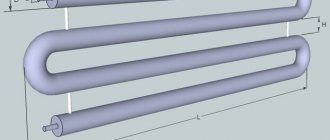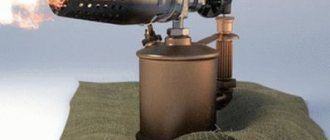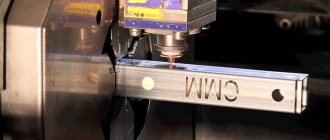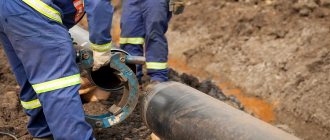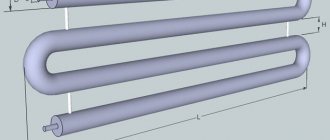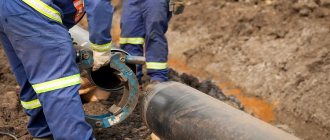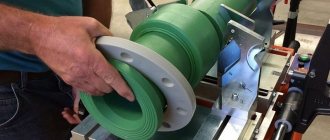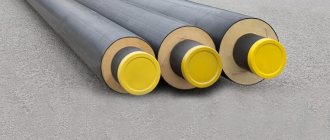To choose the most practical and reliable pipe connection, you need to take into account many factors. First of all, this is the type of medium pumped through the pipeline: water (hot or cold), gas, domestic or industrial wastewater, etc. The material of the pipes, the shape and size of their cross-section, and operating conditions - temperature, load, pressure in the system - are of great importance. There are many docking methods, and for each case the most optimal one should be selected.
Connection of smooth and corrugated pipe Source dentalencenter6.com
Main types of connections
Pipe joining methods can be divided into two categories.
- Detachable - when the joint is fixed using a thread, socket or special fitting (pipe connector), which, if necessary, can be removed to open the pipeline, repair it or replace a section of pipe.
- One-piece - with a permanent fixation of the joint, to open which you will need to cut the pipe.
In household systems, detachable connections are more often used. They are convenient, practical, and allow you to independently install and repair pipelines without complex equipment. For such connections there is a limitation on the pipe diameter:
- 315 mm for flexible pipes;
- 600 mm for rigid pipes.
For pumping gas, chemically aggressive media, as well as when laying long pipelines, preference is given to permanent connections.
Installation of a gas pipeline distribution system Source pravdaurfo.ru
The main subtleties of laying external sewerage
Fittings are used when arranging intra-house or intra-apartment sewerage. The situation is completely different with the external system, which is installed on the site near the house. In this case, it is necessary to start with the construction of wells intended for water purification.
Having understood how to join drainage pipes, it becomes clear that the external system requires products of larger diameter.
It is imperative to take into account the fact that the diameter of the outer pipe should be slightly larger than the size of the sewer pipe. It is better to take material with a “reserve” than to change the entire drainage system when there is a desire to connect new plumbing fixtures.
Having completed the preparatory steps, you can begin the serious business of connecting sewer pipes. According to the types and joints of pipes, two connection options are distinguished: detachable and permanent.
Detachable connections
Connections that can be disassembled without damaging the pipes and with the possibility of reassembling them include threaded, socket and quick-release.
Threaded
Connecting pipelines using threads is one of the most popular joining methods. For cutting threads, a special tool is used - a die; for single joints, you can use a regular die.
Set of dies for thread cutting Source maxmaster.ru
For reference! Threads are rolled onto thin-walled pipes, but doing this at home is problematic due to the need to use special machines.
Threaded connections are sealed and durable, they are easy to install, and allow you to quickly separate joints for dismantling or repairing communications.
The thread can be right or left, external or internal, and differs in pitch and cutting depth, which must be taken into account when connecting two sections.
Quick release (QRC)
Couplers are used on pipelines, the operation of which requires their periodic disassembly. For example, in irrigation systems or seasonal water supply to a country house. These types of pipeline connections are easy to install, allow installation quickly and without the use of tools, and have good tightness and strength.
Fittings-connectors for quick-release connections consist of two parts, each of which is installed on the ends of the pipes being connected.
- The coupling is a receiving part, in the body of which there is a built-in check valve, a rubber gasket-seal, and a fixing clamp.
- Nipple – mating part with connecting adapter.
Cam-type couplings Source prom.st
Couplers may differ in design, material from which they are made, internal diameter, wall thickness and other parameters. For household and household needs, products with a diameter of up to 50 mm are produced. Such fittings are available in different versions: for straight and angular connections, in the form of crosses, tees.
When choosing a connector, be sure to take into account not only the diameter, but also the type of pipes. If they are made of metal-plastic, polyethylene, polypropylene or other plastic and flexible polymer, a large girth along the length of the pipe is required for reliable articulation. Due to their lack of reliability, quick-release methods for connecting pipes are not recommended for hidden laying of pipelines - underground or in a screed.
Coupled and flanged
Medium and large diameter pipes up to 600 mm are often connected using couplings or flanges.
Coupling connection Source strojdvor.ru
Couplings can be used to connect not only identical pipes; they often serve as adapters for products of different diameters or made of different materials.
For hermetically sealed joining of rigid pipes, especially large cross-sections, as well as for insertion into the system of control or auxiliary equipment, flanges are used. They consist of:
- two connecting elements mounted on the ends of the pipes;
- o-ring;
- fasteners - bolts and nuts.
Flange connection Source kanaliza.ru
Flanges are easy to install and disassemble, allowing you to quickly break the connection of pipes without harm to them.
See also: Catalog of companies that specialize in engineering systems (heating, water supply, sewerage and others) and related work
Bell-shaped
Detachable connections of pipelines by joining into a socket are used when installing domestic non-pressure sewage systems. Sewage moves through sloped pipes by gravity; transfer pumps are not used in such systems, so the pressure in them is minimal. This makes it possible not to achieve high strength joints.
The inner diameter of the socket corresponds to the outer diameter of the pipe. To ensure a tight connection, a rubber sealing ring is installed in the socket.
Connecting sewer pipes into a socket Source santehnic-doma.ru
However, a detachable socket connection is used only for plastic sewer lines. Cast iron pipes joined in this way are additionally fixed with cement mortar or sealant. These materials, when hardened, make the joints permanent.
Using repair and mounting clips
Repair and installation clip
An easy to use pipe design that is also quite durable and requires no threading or welding. The repair and installation clip consists of two metal parts, a seal and 4 tightening bolts. Unfortunately, it is not recommended to use the clip for a long period of time - this type of fitting is designed to quickly eliminate emergency situations.
Installing the clip (along with stripping) will not take much time. But the connection must be made carefully, and after installation it is necessary to check its quality.
Sequence of use of the repair and installation clip
- The clip can easily be used to close, for example, a crack in a pipeline without threading or welding. It is not suitable for connecting two pipes. Therefore, after detecting a crack, the area around it should be thoroughly cleaned using fine sandpaper. After cleaning, a clean and smooth surface should be formed on which the seal will fit tightly.
- Next, put a rubber pipe seal over the damaged area so as to completely cover it. The slightest gap will lead to fluid leakage.
- Now you should put two halves of the repair and installation clip on the seal and tighten them with four bolts. There is no need to tighten too much to avoid damaging the threads.
- Let in the liquid and check if the connection is tight enough. If necessary, tighten bolts or nuts.
The simplicity of this method makes it very popular. The second positive quality is that the repair and installation clip has a low cost.
Permanent connections
Permanent methods of connecting pipelines imply their joining without the possibility of dismantling. If it is necessary to replace part of the system, repair or reconstruct it, the pipes have to be cut. These methods include welding and gluing.
Welded
During welding, mutual diffusion of atoms of two joined sections occurs when the material melts under the influence of high temperature. In this way, not only metal pipes are connected, but also plastic and even glass ones. It is indispensable for hidden installation of communications and is very popular when installing technical pipelines in industry.
There are several types of metal welding:
- laser;
- gas;
- electric, which in turn is divided into electric beam and electric arc.
The most popular welding method is electric arc welding Source allaboutpipelines.com
Electric arc welding can be performed using direct or alternating current. The source of melting heat in this case is an electric arc that occurs between the electrode and the metal. Depending on the equipment used, welding can be manual, automatic or semi-automatic.
Pipe joining can be done either end-to-end or overlapping. Products of small and medium sections are welded with one external seam. Large pipes with a diameter of half a meter can be connected with a double seam - inside and outside.
Pipes made of polymers and non-ferrous metals are overlap welded. To do this, use a socket connection.
Made of metal
When installing steel internal water supply pipes, small-diameter pipes with a thin wall are used.
Welding of thin-walled steel pipes is carried out using a gas torch or an electric arc. When inserting the internal comb of an apartment into the riser, a T-shaped connection is used. A hole is made in a pipe with a larger cross-section, and the thin walls of the second pipe are slightly ground off with a grinder for better joining.
There is no cutting of edges with this option. Before welding begins, the parts are cleaned of rust and dirt and joined together. Here it is important to ensure the correct location of the joints. They must be perpendicular or at a certain angle.
When working in procurement shops, as a rule, semi-automatic welding is used. At construction sites, preference is given to gas welding.
After proper joining, tack welding is required to secure the connection. On a small cross-section, 2 tacks are enough; as the diameter increases, the number of tacks increases.
For a non-rotating joint, the ceiling is first welded, then a vertical seam is made and welded in the lower position. This type of work requires the involvement of a qualified specialist.
Pipes of different diameters can be connected through metal adapters or inserted into one another.
If metal pipes of different diameters are inserted into one another, then you can make cuts in the larger pipe, bend the edges, and then weld.
Fittings are usually used for threaded connections of steel workpieces. Welding of registers, welding of barrels to a pipeline when moving gas equipment - this is an incomplete list where it may be necessary to weld pipelines of different sections.
Video description
The process of welding pipes with electrodes is described and shown in the video:
Polymer pipes are welded with a special soldering iron, with which the plastic is heated immediately along the entire circumference of the pipe. After joining the parts, the molten material adheres and, upon cooling, forms a reliable hermetic connection.
This method does not involve butt welding. Installation is carried out using couplings, angles and other connecting fittings, the inner diameter of which coincides with the outer diameter of the pipes. This is how most cold and hot water supply systems are installed, as well as heating systems in private houses and apartments.
How gluing is carried out
The connection of galvanized or plastic pipes must be very strong and reliable. To fasten two tubes together, you can use the gluing method. To glue two parts together, you need to carry out the work comprehensively and step by step.
For this you need:
- Apply the adhesive composition with a brush to the inside of the coupling, and then to the tube;
- Mount the coupling to the mark indicating the insertion depth;
- Leave the glue until completely dry.
While the glue hardens, it is forbidden to move or move the elements. It is important to ensure complete peace of mind. The pipeline can be used no earlier than one day after the work is completed. It is worth noting that the reliability and strength of such a connection largely depends on the correct execution of the work.
All materials for gluing pipes are sold in a hardware store
Among the main mistakes are:
- Uneven application of glue;
- Long interval between connecting parts;
- Drying of the adhesive composition ahead of time.
Such a connection can be ideal even for joining square products. In addition, other joining methods can also be used, which may be dismountable or non-dismountable.
Connection of dissimilar pipes
Often, when installing new or reconstructing old communications, it is necessary to connect sections of pipes made of different materials. For example, metal with plastic or metal-plastic with steel. In such cases, choose one of the methods using special fittings.
- Adapter coupling.
The coupling for connecting metal and plastic pipes has a plastic body and a steel insert with a union nut. A metal pipe is inserted into the threaded part, and a plastic pipe is soldered into the body.
Metal-plastic coupling Source fwater.ru
- Compression double-sided fittings.
One part of such a fitting is put on a plastic pipe and secured to it with a collet connection. This is usually a crimp coupling. The second part is threaded or flanged. To connect a flexible watering hose, the fitting is equipped with a herringbone adapter.
Crimp coupling with flange Source prom.st
- Flange adapter.
Consists of a coupling, flange and adapter, secured with studs or bolts with nuts. When tightening the fasteners, the clamping rings secure the ends of the pipes, forming a strong connection.
Connection using a flange adapter Source ooosoyuz.ru
Note! It is better to trust the joining of pipes of heterogeneous materials to specialists who will select the most suitable method and carry out installation in accordance with all the rules.
Material orientation
When starting serious work - choosing an option for joining sewer pipes, it is important to find out in advance what material you will have to deal with.
Today the following products are used in drainage systems:
The first two types of material are most often used, while the others are quite rare. Corrugated pipes are in demand in external pipelines of private buildings or as components of networks of large production facilities.
Cast iron pipes are used in external drainage systems. Compared to steel ones, they are quite heavy, so they are not suitable for internal sewerage, especially if they are installed by one person. But at the same time, cast iron pipes are not afraid of corrosion, like steel ones, and have a long service life, and are also in demand in heating systems, in particular, when installing risers. Although not every person will connect complex elements in cast iron pipes. The disadvantage of such products is the regular adhesion of waste inside the pipe due to the uneven surface. In winter, during the heating season, they are more susceptible to clogging. Compared to them, polymer products are more practical.
Connection of profile pipes
Profile pipes are called rectangular or square pipes; other, more complex shapes are less common. They are made from metal alloys - steel, aluminum, etc.
This cross-section does not allow their use in systems for transporting liquids, since the presence of corners impedes the movement of flow. Possessing relatively light weight and good strength, profile pipes are used in construction and furniture production for the manufacture of various frame structures.
Greenhouse frame made of profile pipe Source sibdk.ru
It is clear that due to the characteristics of the cross-section, all types of pipe connections used for round pipes cannot be used in this case. Yes, this is not necessary, since the joints of the frame elements should not be airtight. All they need is strength and reliability. They can be provided by:
- arc welding;
- bolted and rivet connections;
- special fittings;
- crab systems.
Welding is performed in the same way as in the case of round pipes.
Holes for bolts and rivets are pre-drilled. Thin-walled pipes can be connected with self-tapping metal screws without drilling.
Joining of pipes using the detachable method
Such connections are classified into flange and coupling. For plastic pipes it is better to use the first option. To achieve excellent tightness, it is better to use cast iron fasteners and rubber gaskets in detachable connections.
Let's look at how to properly connect sewer pipes using flanges step by step:
- Cut the pipe very smoothly, without chamfers.
- Place the loose flange over the cut.
- Insert a spacer protruding 10 cm from the cut line.
- Place a flange on it and connect it to the mating fittings.
- Secure with bolts.
During repairs or installation of pressure/non-pressure systems, coupling connections are used.
For the system to function trouble-free, you need to:
- Before connecting the pipes to each other, cut off their ends at 90°.
- Attach the coupling to the joint so that it is located exactly in the middle of the connector.
- Make a mark on the pipes indicating the location of the coupling.
- Treat the ends of the pipes and the fitting from the inside with a special lubricant.
- Insert one of the pipes into the coupling until it stops.
- Join the pipes without distortion to form a single axis.
- Push the coupling onto the second pipe up to the previously made mark.
This detachable method is very convenient for disassembling the pipeline if necessary. When assembly is performed, great attention is paid to sealing the joint.
READ ALSO: Cross-linked polyethylene pipes for water supply: characteristics and features
Video description
One of the methods for assembling profile pipes with bolts is shown in this video:
When increased strength is not required from the structure, it is assembled using fittings made of hard plastic. they come in the form of couplings, tees, angles, crosses, and are inserted into the ends of the pipes at their joints.
Plastic connectors for corrugated pipes Source odstroy.ru
The elements of the crab system are overhead metal parts with which the structure is fixed using bolted connections. They can also connect pipes along their length, form branches, crosshairs at right angles. The strength of such a connection is not inferior to a welded one.
Crab system - tee Source stpulscen.ru
Made from polyethylene
Welding large-diameter polyethylene pipes requires slightly different work. Large cross-section pipes are welded using the butt method.
To do this, you will need to use a welding machine, a reliable pipe cutter, solvent and rags. A welding machine is a multifunctional unit, which includes a part-centering mechanism, a trimmer, a heater, and a hydraulic station that provides sufficient force when joining heated parts end-to-end.
The equipment runs on electricity. If there are no power supplies nearby, you should prepare a diesel or gasoline generator.
HDPE pipes must be welded in the following order:
- a pipe blank is made according to a sketch or project;
- the parts to be welded are fixed using the machine’s centralizer;
- the ends of the workpiece are treated to remove dirt and oil;
- the trimmer trims edges for welding and cleans parts from chips;
- a heated plate is placed between the ends of the pipes, the ends are pressed firmly against its surface;
- when the ends heat up to melting, the plate is removed, and the workpieces are joined end-to-end;
- Using hydraulics, a certain force is maintained until the joint cools.
In the same way, you can connect HDPE pipes of different diameters. The quality of the connection is affected by the selected heating temperature, the force required to connect the heated parts and the time required to complete all welding cycles.
Features of transition elements
First of all, all transition elements for pipelines are divided into two main types:
- concentric;
- eccentric.
The first group includes fittings that are used for communications located in a vertical plane, and eccentric parts are used for joining pipes in horizontal structures. Both of these groups are actively exploited for economic and industrial purposes.
Let's consider the main materials from which transitions are made:
- steel;
- cast iron;
- brass;
- polypropylene (PP);
- polyvinyl chloride (PVC);
- polyethylene (PE).
For the manufacture of steel transition elements, as a rule, various types of steel are used:
- stainless;
- galvanized;
- carbon;
- alloyed;
- highly alloyed.
For steel pipes, parts are made from the same grades of steel
Note! Fittings made of carbon steel are used in pipeline structures that transport slightly aggressive and moderately aggressive working media. In turn, products made from alloy and high-alloy steel are used in more severe conditions.
Every year, plastic fittings are becoming more widespread, displacing steel products. This is due to the fact that they are light weight, corrosion resistant, and also more affordable.


